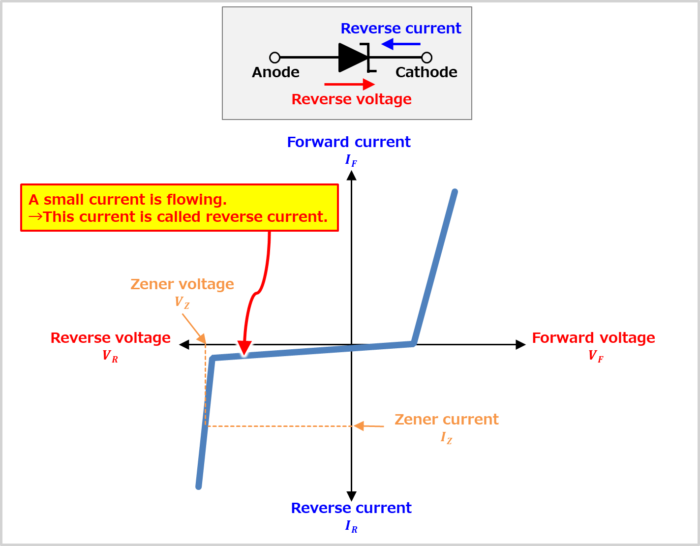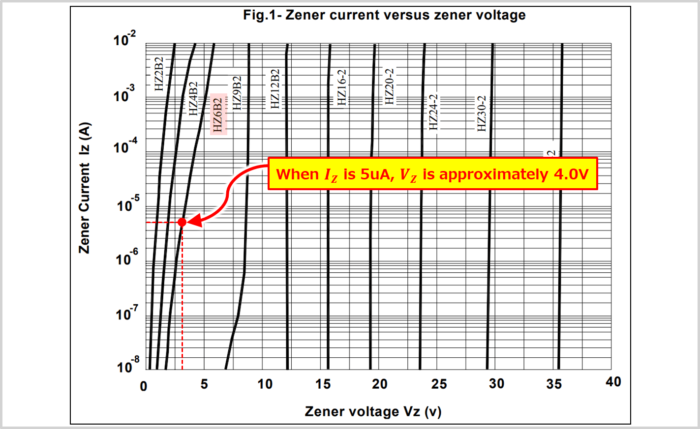The reverse current in a zener diode is the current that flows in a minute amount when a reverse voltage is applied.
Regarding the reverse current in a zener diode: This article will explain the information below.
- Reverse Current of Zener Diodes
- How reverse current is described on the datasheet
Reverse Current (Leakage Current) of Zener Diode

The above figure shows the "current-voltage characteristic" of a zener diode. In the "current-voltage characteristic," the horizontal axis represents the voltage applied to the zener diode and the vertical axis represents the current flowing through the zener diode.
When the reverse voltage (the voltage when the cathode is positive and the anode is negative) applied to a zener diode is gradually increased, a breakdown phenomenon occurs and the current begins to flow rapidly at a certain point.
The voltage at which the current begins to flow rapidly is called the zener voltage (breakdown voltage) \(V_Z\). The current flowing after the breakdown phenomenon occurs is called the zener current \(I_Z\).
Ideally, no current flows through the zener diode until the reverse voltage reaches the zener voltage \(V_Z\). In reality, however, a small amount of current does flow. This current is called reverse current.
Supplement
- Reverse current is also called leakage current.
- The symbol for reverse current is represented by \(I_R\). The \(I_R\) is derived from the initial letter R of reverse.
- Since reverse current \(I_R\) is a current that we do not want to flow, the smaller it is, the better the characteristics of the zener diode.
How reverse current (leakage current) is described on the datasheet

The above figure shows the datasheet for the Renesas HZ6B2 zener diode. The reverse current of the zener diode is shown in green in the above figure.
The appearance on the datasheet varies from manufacturer to manufacturer, but in the case of the datasheet shown above, the reverse current is described as follows.
- Reverse current : \(I_R=5{\mathrm{μA(MAX.)}}\)
- Measurement condition : \(V_R=2{\mathrm{V}}\)
This means that when a reverse voltage \(V_R\) of 2.0V is applied to the zener diode, the maximum reverse current \(I_R\) is only 5uA. Note that the minimum (Min) is not listed on the datasheet, which means that the manufacturer does not guarantee the minimum value of reverse current.
In addition, let's look at the orange areas in the table above. When the zener current \(I_Z\) is 5mA, the zener voltage \(V_Z\) has a minimum value (Min.) of 5.6V and a maximum value (Max.) of 5.9V. This indicates that when the zener current \(I_Z\) is 5mA, the zener voltage \(V_Z\) will be in the range of 5.6V to 5.9V.

In addition, "characteristics of zener voltage \(V_Z\) on the horizontal axis and zener current \(I_Z\) on the vertical axis (\(V_Z\)-\(I_Z\) characteristics)" may be shown on the datasheet. The figure above shows the (\(V_Z\)-\(I_Z\) characteristics of "HZ6B2.
Looking at the \(V_Z\)-\(I_Z\) characteristics shown in the figure above, we can also see that the zener voltage \(V_Z\) is 4.0V when the zener current \(I_Z\) is 5uA, which does not match the values in the previous table. This may seem contradictory, but the table above shows that when reverse voltage \(V_R\) is 2V, the reverse current \(I_R\) can only flow up to 5uA "at most". The \(V_Z\)-\(I_Z\) characteristic shown in the above figure is only a zener diode characteristic, so there is a difference from the value in the table.
Supplement
- Datasheets usually list MAX., TYP., and MIN. If MAX., TYP., or MIN. are not listed, it means that the manufacturer does not guarantee how much each value will be.
Summary
In this article, the following information on "Reverse Current (Leakage Current) of Zener Diode was explained.
- Reverse Current of Zener Diodes
- How reverse current is described on the datasheet
Thank you for reading.
Related article
"Information about Zener diodes" is explained in detail in the following articles. If you are interested, please check it out from the link below.